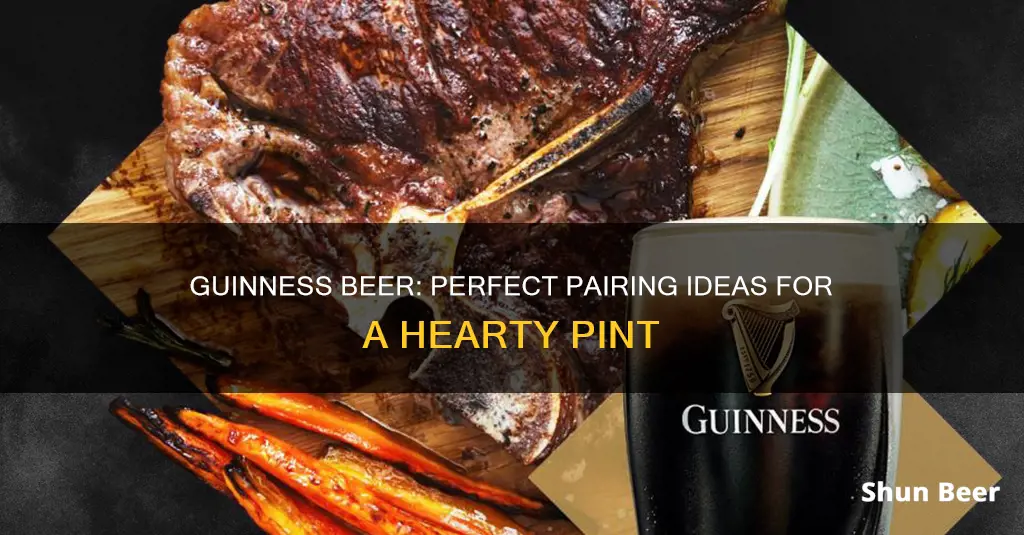
Guinness is a traditional Irish stout beer made from barley, hops, water, and a specific strain of ale yeast. It is one of the most successful beer brands worldwide, brewed in almost 50 countries, and available in over 120. It is often considered Ireland's national drink and is excellent for food pairings. So, what goes with Guinness beer?
Guinness is a versatile drink that can be enjoyed on its own or used as an ingredient in cocktails and food recipes. Its unique, rich, caramelized flavor makes it a perfect pairing for hearty meals, such as Irish stew, bangers and mash, soda bread, and savory pies. It also goes well with savory apple dishes, smoked meats, and fruity desserts with a hint of chocolate.
When it comes to cocktails, Guinness is a great base for creative mixes. Some popular options include the Irish Car Bomb, Black Velvet, and Bloody Mary. For a sweet treat, you can even make a Guinness float by pouring the stout over vanilla ice cream.
In terms of food, Guinness is not just for drinking; it can also be used in cooking. The brand's website features recipes that use Guinness, such as Irish mashed potato croquettes with Guinness Draught cheese sauce and Baltimore Blonde fried chicken.
| Characteristics | Values |
|---|---|
| Type | Stout |
| Colour | Dark |
| Flavour | Caramelized |
| Mouthfeel | Smooth, velvety |
| Head | Dense, creamy |
| Calories | 125 per pint |
| Alcohol by volume | 4.1% to 4.3% |
| Ingredients | Water, barley, hops, brewer's yeast |
| Pairings | Irish stew, bangers and mash, soda bread, pies, apple dishes, smoked meats, British fruit tarts |
| Cocktails | Bloody Mary, Irish Car Bomb, Black Velvet, Affagato, Jamaican Guinness Punch, Hot Fudge Guinness Float |
What You'll Learn
- Guinness cocktails, including Irish Car Bomb Jelly Shots and Bloody Mary
- Guinness in food, including Irish mashed potato croquettes and fried chicken
- The history of Guinness, including its original brewery in Dublin
- The health benefits of Guinness, including its antioxidants and B vitamins
- How to serve Guinness, including the recommended glass and temperature?

Guinness cocktails, including Irish Car Bomb Jelly Shots and Bloody Mary
Guinness Cocktails
Irish Car Bomb Jelly Shots
The Irish Car Bomb cocktail is a type of boilermaker, a drink in which a shot of liquor, usually whiskey, is dropped into a beer. The Irish Car Bomb uses Guinness as the beer, with a shot that is a two-part mixture of whiskey and Irish cream. The shot is created by combining equal portions of whiskey and Baileys Irish cream in the same shot glass, slowly layering the whiskey on top of the cream. The shot is then dropped into a half-full glass of Guinness. The drink should be consumed quickly, as the Irish cream will curdle in the beer if left for more than a few seconds.
The original name of the cocktail was the "Irish Car Bomb", but this name is considered offensive and has fallen out of use. Alternative names include the "Irish Shot", "Irish Slammer", "Dublin Drop", or simply the "Irish Bomb".
Bloody Mary
A Bloody Mary is a classic cocktail that can be given an extra kick with the addition of Guinness. To make a Guinness Bloody Mary, simply prepare a Bloody Mary with your choice of ingredients—traditionally including tomato juice, lemon juice, horseradish, celery salt, hot sauce, Worcestershire sauce, salt, pepper, and vodka—and top it off with a splash or two of Guinness. The Guinness adds a unique flavour to the Bloody Mary, making it a little creamy without being too frothy, and enhancing the savoury flavour.
A Guinness Bloody Mary is a great option for brunch, especially on Saint Patrick's Day, and can be paired with any brunch food, from breakfast dishes to Irish stew.
Other Guinness Cocktails
Guinness can be used in a variety of other cocktails, including:
- Mixing stout with blackcurrant cordial.
- Combining dark rum, espresso, vodka, crème de cacao, and stout.
- Simmering apple juice, stout, a cinnamon stick, and star anise, then serving with honey.
- Mixing stout with chilled champagne.
- A Guinness Black Russian: combining coffee liqueur, vodka, cola, and stout.
Guinness Beer and Caffeine: What's the Connection?
You may want to see also

Guinness in food, including Irish mashed potato croquettes and fried chicken
Guinness in Food
Irish Mashed Potato Croquettes
The official Guinness website features a recipe for Irish mashed potato croquettes with a Guinness draught cheese sauce. The sauce is made by adding evaporated milk, Guinness draught, Dijon mustard, Worcestershire sauce, and grated sharp cheddar and pepper jack cheese to a saucepan and heating until the cheese is melted and the sauce is smooth. The croquettes are made by mashing potatoes with leek, kale, savoy cabbage, garlic, and spring onions, and then forming the mixture into small croquette shapes. The croquettes are then coated in flour, egg, and breadcrumbs (panko or dry), and deep-fried. The croquettes are served with the cheese sauce and garnished with chopped parsley.
Guinness Beef Stew
Guinness is a popular ingredient in beef stew, adding a rich, deep flavour to the dish. The stew typically includes beef, garlic, onion, bacon, carrot, celery, flour, tomato paste, chicken or beef stock, and herbs such as thyme and bay leaves. The beef is browned and then simmered with the vegetables, Guinness, and stock for several hours until tender. The stew is often served with mashed potatoes or Irish soda bread.
Guinness Chicken
Guinness can also be used in chicken dishes, such as sticky Guinness chicken. The dish is made by creating a glaze with Guinness, ketchup, honey, balsamic vinegar, Dijon mustard, and garlic. Boneless, skinless chicken thighs are browned in a pan and then coated in the glaze. The sauce thickens and becomes sticky as it cooks, creating a finger-licking good dish.
Guinness Beer's Ball: A Unique Brewing Mystery
You may want to see also

The history of Guinness, including its original brewery in Dublin
Guinness is a great ingredient for cocktails, including the Black Velvet, Irish Car Bomb Jelly Shots, and the Bloody Mary. You can also try the Jamaican Guinness Punch, or the Guinness Double Chocolate Malted Milkshake.
The history of Guinness begins with Arthur Guinness, who was born in 1725 in County Kildare, Ireland. In 1755, Guinness inherited £100 from his godfather Archbishop Price and used the money to lease a brewery in neighbouring Leixlip, Kildare. Here, he brewed ales until 1759, when he moved to the larger St. James's Gate Brewery in Dublin, signing a 9,000-year lease at £45 per year.
While at St. James's Gate, Guinness began brewing porter (stout) in the 1770s. This new type of English beer was brewed from roasted barley, giving it a rich, dark colour and aroma. Guinness's dark, creamy porter became so popular that the Guinness Brewery was one of two official suppliers of beer to the seat of government at Dublin Castle. By 1799, Guinness had stopped brewing ales altogether and was focusing solely on brewing porter.
When Arthur Guinness passed away in 1803, the brewery was producing 20,000 barrels a year and had built up a successful export trade. The business was inherited by his son, Arthur Guinness II, who continued to expand the St. James's Gate Brewery. By the 1830s, it was the largest brewery in Ireland. Arthur Guinness II focused on the export trade, with shipments heading to destinations like New York, South Carolina, Lisbon, Barbados, and Sierra Leone from the 1820s.
In the 1850s, Arthur Guinness II's son, Benjamin Lee Guinness, took over the business. Under Benjamin, the business established the first trademark label for Guinness Stout in 1862, which included iconic features like Arthur Guinness' signature, the Harp device, and the name "GUINNESS". The success of the business elevated the Guinness family's status, and Benjamin became Lord Mayor of Dublin in 1851.
After Benjamin died in 1868, his son Edward Cecil Guinness took over the business. In 1886, Guinness became the world's largest brewery and floated on the London Stock Exchange. By the end of the 19th century, Guinness was producing 1.2 million barrels of porter every year, and the brewery had expanded to 60 acres with its own railway and fire brigade.
In the 20th century, Guinness continued to expand internationally, with breweries opening in London, Nigeria, Malaysia, Cameroon, and Ghana. In 1997, Guinness merged with another company, Grand Metropolitan, to form Diageo PLC, which still owns the Guinness brand today.
Today, there are Guinness breweries in over 60 locations, and Guinness is sold in over 150 countries, with 10 million glasses of the dark, creamy stout enjoyed every day around the world. The original St. James's Gate Brewery in Dublin remains a popular tourist attraction, with over 20 million visitors since opening its doors to the public in 2000.
Guinness Beer: Kosher Certification and Jewish Drinking Traditions
You may want to see also

The health benefits of Guinness, including its antioxidants and B vitamins
Guinness beer has long been associated with health benefits, from its nutritional content to its potential impact on heart health. Here are some key points highlighting the health benefits of Guinness, including its antioxidants and B vitamins:
Antioxidants and Heart Health
Guinness contains antioxidants, specifically heart-healthy polyphenols derived from barley and hops. These polyphenols have been shown to lower cholesterol, reduce the risk of heart disease, and protect against free radicals. A 2003 study also suggested that a pint of Guinness could reduce the risk of blood clots forming in the arteries, a benefit not observed with other beers.
B Vitamins
Guinness is a source of B vitamins, including folate. Folate is essential for DNA synthesis and cell division. According to research by brewing expert Charles Bamforth, stouts like Guinness contain an average of 12.8 micrograms of folate, contributing to 3.2% of the recommended daily allowance.
Other Nutrients
In addition to antioxidants and B vitamins, Guinness provides fiber, silicon, and prebiotics. The fiber content in Guinness is notable due to its high proportion of unmalted barley, which contains more fiber than malted grain. Silicon, or dietary silicon, may play a role in protecting against osteoporosis. Prebiotics promote the growth of beneficial bacteria in the gut.
Lower Calories and Alcohol Content
Compared to other beers, Guinness has a slightly lower alcohol content, typically around 4.2% to 4.3% ABV, while popular lagers often start at 5% ABV. As alcohol is the main source of calories in alcoholic beverages, Guinness tends to be lower in calories. This makes it a relatively "light" beer, despite its rich flavour and creamy texture.
While Guinness may offer some health benefits due to its nutritional content and potential positive effects on heart health, it is important to remember that excessive alcohol consumption can lead to various health problems. Moderate consumption, as defined by dietary guidelines, is generally considered safe and may even provide some health benefits.
Guinness Beer: Does It Expire?
You may want to see also

How to serve Guinness, including the recommended glass and temperature
Guinness is a traditional Irish stout beer, often considered Ireland's national drink. It is best served cold in a pint glass at a temperature of 42 degrees Fahrenheit (or 6-7 degrees Celsius), though no higher than 50 degrees Fahrenheit. The ideal serving temperature for Extra Cold Guinness is 38 degrees Fahrenheit (or 3.5 degrees Celsius).
The two-part pour is a well-known ritual for serving Guinness on tap. To begin, the glass should be dry and tilted at a 45-degree angle. The Guinness is poured onto the side of the glass until it is three-quarters full, allowing the head to develop. Then, the glass is brought to a vertical position and topped off. This method helps to create the dense, creamy head that Guinness is known for.
For bottled Guinness Draught, a two-part pour is also recommended. The bottle or can should be cracked open and allowed to rest so that the nitrogen can carbonate the beer. The beer is then poured slowly and smoothly. Chilling the cans for at least three hours beforehand is also suggested.
Guinness should not be served in a chilled or frosty glass, as this can ruin the flavour and head. Additionally, the recommended serving time for a pint of Guinness is two minutes.
Guinness Beer: German or Irish?
You may want to see also
Frequently asked questions
Guinness is a traditional Irish stout beer made from barley, hops, water, and a specific strain of ale yeast.
Guinness is an excellent stout for food pairings. Keep it authentic by serving the beer alongside classic Irish dishes like Irish stew, bangers and mash, soda bread, and hearty, savory pies. The stouts are also excellent with savory apple dishes and smoked meats.
There are many cocktails that can be made with Guinness, including the Irish Car Bomb, Bloody Mary, and Black Velvet.
All Guinness beers are best served cold in a pint glass. The ideal temperature for Extra Stout, Draught, and Blonde is 42 degrees Fahrenheit, but no higher than 50 degrees. When the beer is too cold, the aroma and flavor will not open up all the way. The recommended serving temperature for Extra Cold is 38 degrees Fahrenheit.







